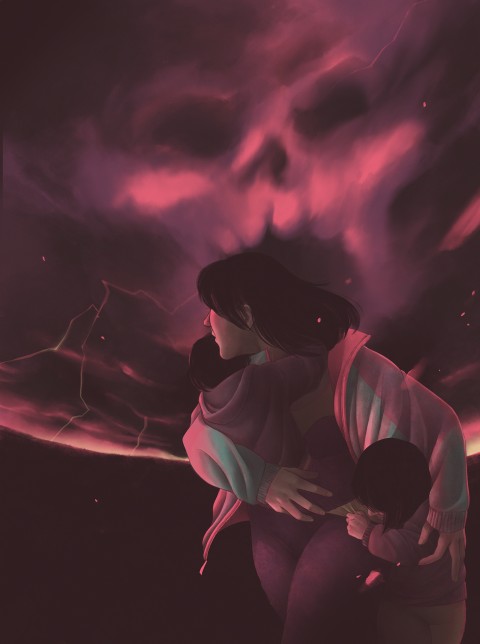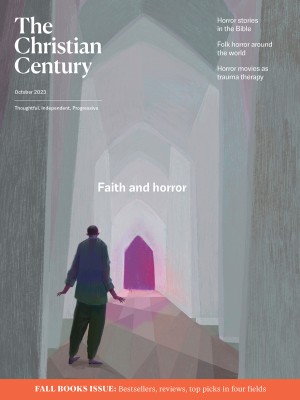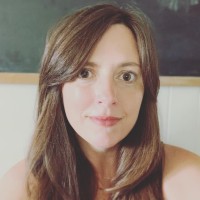Horror movie mom
When I watch a mother slay a monster and hustle her kids to safety, it never fails to satisfy.

(Illustration by Benedetta Vialli)
My mom was a night owl who would stay up for hours after my dad had fallen asleep in his recliner and my older sister and I were in our beds. In the dim lamplight she’d watch movies on HBO while doing the TV Guide crossword. For years after she died, wherever I lived, I couldn’t sleep without the TV murmuring in the empty living room.
She loved horror movies. She preferred supernatural thrillers to gruesome slashers—though we did rent a VHS tape of A Nightmare on Elm Street. “The worst part of this one,” I remember her saying as she served me a take-out burger on my TV tray, “is it makes you afraid to fall asleep.” I think I was ten. Before she got sick and scared and descended into a fundamentalism she thought would save her, this woman dressed our family of four as the band Kiss for Halloween.
Read our latest issue or browse back issues.
My sister didn’t like horror movies then. She had her first panic attack after she saw the voodoo-zombie film The Serpent and the Rainbow and developed a fear of being buried alive. Horror felt like something special my mom shared only with me while my sister was out with her friends. Together, we watched The Exorcist (a rite of passage for a Catholic child) and also sillier fare like Fright Night, in which Chris Sarandon plays a handsome vampire who moves in next door, and Witchboard, about a woman who becomes possessed by an evil spirit after using a Ouija board.
Those tastes fit with the mom I remember as perpetually girlish—only 36 when she died—and a little spooky, a typical New Orleans Catholic whose religious practice was infused with folk traditions and what most people would call superstitions. She made the sign of the cross when we drove past a cemetery and traced an X on the windshield with her finger if a black cat crossed in front of our Chevy Monte Carlo. She knocked on wood to avoid jinxes, threw spilled salt over her left shoulder to blind the devil. She told me celebrities died in threes and that if I heard a bird singing at night, someone in the family would die. Pregnant with me, she hung her wedding ring from a chain and dangled it over her belly to determine if I was a boy or a girl. I was born a girl (the pendulum was wrong) but exactly on my due date, Friday the 13th. She said that was good luck.
She died when I was 14 after a short, brutal illness made more brutal by experimental cancer treatment. Thirty years later, my memories of her life have blurred with the horror movies we watched.
When I watch JoBeth Williams as Diane Freeling in Poltergeist, I imagine I feel a shadow of what some of my friends with living mothers feel when they go home to visit. The interior of the Freelings’ suburban home in Cuesta Verde, California, built on a graveyard where real estate developers only removed the headstones, feels more familiar to me than my childhood home in Louisiana.
Diane’s initial enthusiasm for the supernatural presence in her home reminds me of my mom. I can imagine her waiting eagerly for my dad to get home from work so she could show him how the kitchen chairs were rearranging themselves, clapping and laughing in astonishment. I can see them smoking pot in their bedroom and giggling like Diane and her husband do. I can also see my mom crossing into the light of another dimension to save me from malicious spirits. But there is a crucial difference between the two of them. Diane Freeling lives.
I’m an anxious person, prone to panic attacks, a worrier. I can’t bear to see any living creature suffer. I abhor violence and gore. My various diagnoses over the years have included generalized anxiety disorder and complex PTSD. And yet horror movies feel almost medicinal for me.
Trauma researchers have found that watching horror movies really can be therapeutic for people with PTSD. We may be drawn to these stories by a repetition compulsion—the impulse to seek out familiar feelings of imminent threat as a paradoxical comfort. This also plays out in our real lives as a tendency to feel more stable in the midst of chaos. When you live in fight or flight mode, you’re at your best in a crisis, and you’re always ready to run.
In the later movies in the Halloween franchise, decades after surviving the homicidal serial killer Michael Myers, Laurie Strode—a middle-aged Jamie Lee Curtis reprising her original scream queen role—remains paranoid and hypervigilant. The beautiful teenager has become a wild-eyed woman, a mother and a grandmother who doesn’t fit in with polite company. She’s often an embarrassment to her family, but she knows exactly what to do when the killer strikes again. And again.
Trauma survivors may also experience relief, a kind of proxy satisfaction, when horror re-creates the panic and confusion we endured in real life, enabling us to observe it, study it, and control it at a physical and emotional distance. A scene in Midsommar, a film that self-consciously explores the relationship between trauma and horror, gestures toward this experience. The heroine, Dani, and her friends travel to a remote Swedish community and observe a horrifying ritual. While the cult members stand in reverential silence, the visitors, except for Dani, react to what they see with panic and confusion. They cover their eyes or mouths while they scream; one of them vomits. ”You’re just standing there watching?!” one guy asks. “What the fuck is wrong with you?” In a close shot we see Dani’s green eyes, unblinking. Her breath comes faster, but she doesn’t look away. She’s not experiencing this event as the others are. She’s reliving her own trauma. Realism and melodrama don’t re-create that kind of visceral fear, distorted perception, and physical distress I experienced watching my own mother die, but horror does.
But horror as medicine isn’t quite the whole story. In my favorite horror movies—Poltergeist, Rosemary’s Baby, the later Halloween movies, The Babadook, Bird Box, even the Netflix series Stranger Things—the heroes are mothers who survive and protect their children. Diane Freeling fights the monsters who threaten her family, and she wins. When I watch a conventional melodrama about a mother who survives cancer, I feel very little, but when I watch a mother slay a monster and hustle her kids to safety, it almost never fails to deliver a deep emotional satisfaction.
I also feel an approximation of relief that in real life never comes. Trauma goes on, compounding over time. In the horror movie, it comes and is vanquished. But most importantly, I see what my own mother wasn’t able to give me: a model of a traumatized woman who is both a survivor and a protector.
I’m a mother myself now, ten years older than my mother was when she died. There’s no script for me. Maybe this is the real reason why, when I have an evening to myself to relax, I watch a horror movie. My kids don’t share this fascination. My tween son scares easily, and my teen daughter’s tastes are already more sophisticated than mine. (Recently she went to a screening of Terrence Malick’s Days of Heaven at the local university, while I stayed home and watched Paranormal Activity 3.) I like to think I have worked hard to shield them from the experiences I had growing up—and that this is why they don’t need horror the way I do. So far we have been lucky. Even writing that I feel my mother’s superstitions sneaking up on me. Have I jinxed us?
In the last months of my mother’s life, both she and my father descended into a new form of the magical thinking that had always been a part of my family. We had a vial of holy water from the girl saint Bernadette’s miraculous, healing spring in Lourdes, France, on top of our refrigerator for as long as I could remember, almost like a fire extinguisher, for use in case of emergency. Now they turned to other places for healing: MD Anderson Cancer Center in Houston and the Osteens’ nearby Lakewood Church. Neither of them gave better results than the holy water.
During that time religion became its own horror: The strangers who started coming to our house to pray with us. The Bible verses whispered in the night when we cried. The talk of miracle cures that could be won if we only believed. When my mom died anyway, I lived with the implication that it was some kind of punishment for a lack of right living or right belief, both mine and hers.
The truth is, I never believed that if I prayed the right way or believed the right things my mother would live. I accepted that she was going to die before anyone else did. The burden of that knowledge and my family’s denial of it made me angry, and my adolescent anger made me fearsome. Even my peers were afraid; they never looked at me quite the same once I became the girl whose mother died.
I recognize my younger self in the teenage Thomasin in Robert Eggers’s The VVitch: A New-England Folktale, who seems to take a perverse satisfaction in fulfilling her fundamentalist family’s worst expectations of her. In the end, she becomes what they tell her, unjustly, at first, that she is: the Witch of the Wood. As I watch her float into the night sky around a ritual fire, I always think to myself, Good for her.
If what remained of my family prayed together the night my mother died, I have forgotten. In my memory, there is only darkness and silence. When my dad, sister, and I went to bed after leaving the hospital, we were inexplicably afraid. We didn’t turn on the lights or the television. We slept together in my sister’s room, my dad on a pallet on the floor. I lay there still with the covers pulled to my chin, listening to them breathe. I had the feeling that something powerful had taken notice of my family, that we had attracted the eye of something monstrous.
All this time later, I can still recall that feeling. All those months of fervent prayer and altar calls and speaking in tongues, I never felt a thing. That night remains my most authentic religious experience. The portal to some dark numinosity opened, and it never closed.
My mother’s death led to yet more tragedies—“bright-eyed disasters flooding out of a death hole like bats out of a cave,” Karen Russell writes in Swamplandia, another horror story about a daughter grieving her mother. My close-knit extended family disintegrated to almost nothing by the time I graduated from college. It seemed like we were always at a funeral, one fewer around the casket each time, until it was just me and my sister in our black dresses and sunglasses. The Halloween films’ aging Laurie Strode interests me in part because I see her living out the question I’ve been asking myself since my mother died: What does it mean to be the one who survives? In horror movie parlance, she’s known as the final girl, and we don’t usually get to see her grow up and grow old.
She’s me. The woman who will, who must, survive with the terrible knowledge that makes her always feel like a bit of an outcast. On my bedroom wall, I have a gallery of icons, portraits of horror movie moms my friend Joanna drew for me. JoBeth Williams as Diane Freeling in Poltergeist. Mia Farrow as Rosemary Woodhouse in Rosemary’s Baby. Winona Ryder as Joyce Byers in Stranger Things.
My kids say I remind them of Joyce, the anxious mother who will do anything to protect the children of Hawkins, Indiana, from the dangers of the Upside Down. There is a resemblance; we have the same haircut, and yeah, Joyce is kind of a mess. I sometimes feel as bedraggled, neurotic, and hypervigilant, like I’m carrying my children on my back to safety. Still, I’m pleased by the association. When I’m gone, they’ll be able to commune with my spirit when they watch those old episodes. I hope they’ll remember me the way I remember my own mom when I watch Diane Freeling, recognizing a similar capacity for wonder and a courageous, if not fearless, love.
* * * * * *
Christian Century community engagement editor Jon Mathieu chats with author Jessica Mesman about her personal experiences and the horror films Poltergeist, Stranger Things, The Babadook, and Midsommar.






